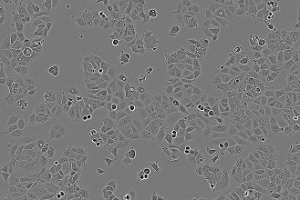Cell Line Profile MCF7
(ECACC catalogue no. 86012803)
Cell line history
MCF7 was derived from the pleural effusion from a 69 year old female suffering from a breast adenocarcinoma1. It was named after the Michigan Cancer Foundation (MCF) and is the most studied human breast cancer cell line in the world2.

MCF7 cells 48hr post seeding
Key characteristics
MCF7 cells are of interest because they maintain a number of characteristics similar to mammary epithelium. The cell line has an epithelial-like morphology and monolayers form dome structures due to fluid accumulation between the culture dish and cell monolayer. It is one of few breast cancers that express the oestrogen receptor alpha (ER-α)3-5. The cells also express androgen, progesterone and glucocorticoid receptors making them valuable tools in medical research. Treatment of MCF7 with oestrogens has been shown to have an anti-apoptotic effect6, 7 whereas treatment with anti-oestrogen chemotherapy drugs (e.g. tamoxifen) can reduce growth of cultures by inhibiting proliferation and inducing apoptosis8, 9.
Soon after derivation the MCF7 cells were shown to be genetically unstable10-13 with cell lines from different labs shown to perform differently14. Different cellular subpopulations have also been shown to exist in growing cultures with the identification of a stem cell fraction capable of regenerating the remaining subtypes15. A number of MCF7 variants have been intentionally developed16 including lines hypersensitive to oestrogen which may be ER-positive or ER-negative17, 18. There are also a number of chemotherapy resistant lines which have recently been added to the collection (see related cell lines below).
Note that the supposed Adriamycin resistant variant MCF-7/ADR has now been confirmed as a misidentified cell line and is not a derivative of MCF7. This cell line has now been identified as the ovarian cancer cell line Ovcar8.
Applications
MCF7 are primarily used as an in vitro model to study breast cancer biology. Due to the number of variants available, it has applications in development of chemotherapeutic drugs and understanding drug resistance.
Culture tips
Cells may carry B or C type retrovirus and are considered to represent a category 2 pathogen.
Cells should be grown in EMEM (EBSS) media supplemented with 2mM glutamine, 1% non-essential amino acids (NEAA) and 10% foetal bovine serum (FBS), seeded at a density between 2-4x104 cell/cm2 and subcultured when 70-80% confluent.
It has been demonstrated that phenol-red, a common additive in cell culture media, is a weak oestrogen and can bind to the receptors found on MCF719, 20. For studies looking at oestrogen activity the use of phenol-red-free medium is advised. ECACC offers a related cell line, MCF7/S0.5 (ECACC no. 16022501), which is adapted to grow on low serum and phenol-red-free media and may be more suitable for hormone-related studies.
Due to the instability of the MCF7 cell line and the existence of different subpopulations it is particularly important to complete work from a defined working cell bank of frozen stock. It is also important to consider the source of cells as those from different laboratories or depositories may behave differently.
|
Related cell line |
ECACC catalogue number |
Description |
|---|---|---|
|
MCF7/S0.5 |
Human, Breast, Cancer, oestrogen receptor, MCF7. Adapted to grow in low-serum media. |
|
|
MCF7/182R-6 |
Breast cancer, fulvestrant resistant |
|
|
MCF7/AnaR-4 |
Breast cancer, MCF7, Anastrozole resistance |
|
|
MCF7/ExeR-4 |
Breast cancer, Exemestane resistance |
|
|
MCF7/LetR-1 |
Breast cancer, Letrozole resistant |
|
|
MCF7/TAMR-7 |
Breast cancer, tamoxifen-resistant |
|
|
**MCF-7/ADR** |
Misidentified cell line: Actually derived from Ovcar8 (ovarian cancer). Re-designated NCI/ADR-RES21, 22 |
|
